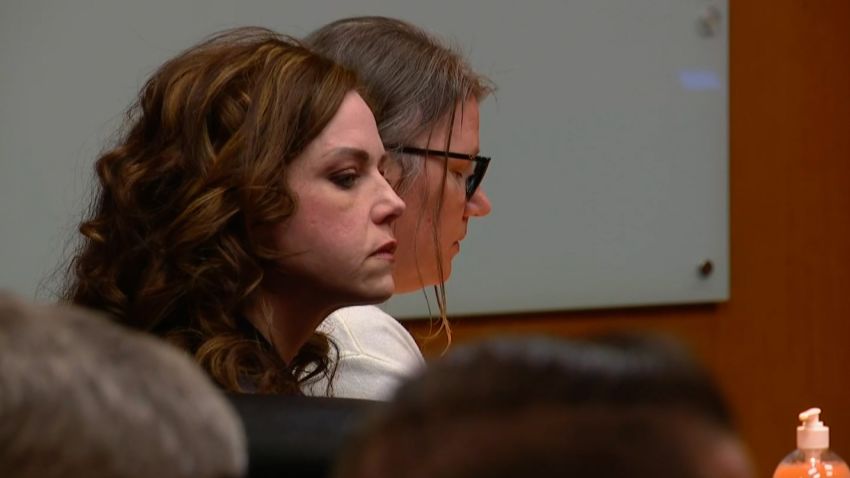Editor’s Note: Jennifer Tucker, PhD, is a professor of History at Wesleyan University and the founding director of Wesleyan’s Center for the Study of Guns and Society. She is a member of the Historians Council on the Constitution at the Brennan Center for Justice at NYU Law School. The views expressed in this commentary are her own. View more opinion at CNN.
Jennifer Crumbley, the mother of a teenager who shot and killed four students and injured seven others at an Oxford, Michigan school in 2021, was found guilty Tuesday of all four counts of involuntary manslaughter. For this novel legal case, the jury of 12 deliberated for over 10 hours. Her son, Ethan Crumbley, who was 15 at the time of the shooting, pled guilty to one count of terrorism causing death, four counts of murder and 19 other charges related to the shooting and was sentenced last year to life in prison without parole. She’ll be sentenced on April 9.

Her defense attorney, Shannon Smith, said Ethan’s crime was so horrendous that “it was unforeseeable.” But prosecutors disagreed, saying that the teen’s parents were aware that he was in crisis and had access to a gun and willfully disregarded the warning signs anyway. They alleged the parents bought their 15-year-old a 9mm Sig Sauer SP 2022 pistol as an early Christmas gift, a purchase that violated Michigan law. In the judge’s instructions to the jury, the key concept in determining guilt was that of “gross negligence.”
Although parents of mass shooters have been prosecuted in civil court before, the trial of Jennifer Crumbley (and that of the father, James Crumbley, set to begin in March) marks the first time in US history that parents have been charged in criminal court for a mass school shooting committed by their child –and now one has been convicted.
Prosecutors alleged that the Crumbley parents willfully disregarded warning signs that their son was in crisis, did not heed concerns of school administrators, bought him a gun days before the shooting and failed to lock it up. On the morning of the shooting, a teacher found a drawing on Ethan’s desk of a gun, bullet and shooting victim with the words “blood everywhere” and “the thoughts won’t stop, help me.” The teacher notified school authorities, who warned both Crumbley parents and said their son would require counseling.
According to one prosecutor, both parents “resisted the idea” of their son leaving school at that time and “failed to ask if their son had his gun with them or where his gun was located and failed to inspect his backpack for the presence of the gun, which he had with him.”
The question of who may bear responsibility when a minor carries out a shooting has gained fresh scrutiny in recent years, and it’s not just parents under the microscope. Others who could potentially bear liability but remain as yet undetermined range from gun manufacturers that advertise to children to weapons makers that create locks that allow customers to circumvent state bans on assault weapons. Attention has also fallen on Hollywood directors, who perpetuate false and misleading ideas about how guns are used in the real world.
Another trial currently underway in Buffalo, New York explores the role of social media platforms that are accused of emboldening another shooter, Payton Gendron, who was 18 when he killed 10 people and injured three others in a racist attack at a supermarket in May 2022. Most of the social media companies have generally been hesitant to comment publicly.
This case also involves novel legal theories, with plaintiffs arguing that social media and body armor companies enabled the killer. A representative for RMA Armament, the company that sold body armor to the accused Buffalo shooter, said in an email to the Buffalo News, “RMA Armament is saddened by the senseless act of violence that occurred in Buffalo … Our products are intended for the protection of law-abiding private citizens, police departments and government partners.” The armor Gendron was wearing prevented a retired police officer at the scene from stopping the shooting.
Plaintiffs’ attorneys contend that, like opioid drug products, these social media platforms, which include White supremacist content, are designed to create addiction. Yet last week, the social media companies asked the judge to dismiss the case, arguing they cannot be held responsible for actions of third-party users. Like gun manufacturers, weapons dealers and others, they lay blame at the feet of only one person: the teen shooter.
Stemming the tide of gun violence
As gun laws are relaxed and guns and ammunition become increasingly lethal, it’s clear that simply pathologizing individual “bad actors” isn’t sufficient to stem the tide of gun violence in this country. The US has by far the highest rate of child and teen firearm mortality among peer nations, and in 2020, firearm injuries became the leading cause of death among US children and adolescents. In contrast, firearms do not make the top four causes of death for young people in any other similarly large, wealthy country.
Often, the risk to children resides right at home. According to the Giffords Law Center, “Studies show that between 70% and 90% of guns used in youth suicides, unintentional shootings among children and school shootings perpetrated by shooters under the age of 18 are acquired from the home or the homes of relatives or friends.”
In the Crumbley trial, there was a focus on how, and whether, guns were secured in the home. Currently, gun owners face criminal charges for the negligent storage of firearms where a child can gain access in 26 states and the District of Columbia. However, there are no federal laws requiring the safe storage of guns.
Yet, research shows that even parents who think their guns are inaccessible to minors are mistaken. For example, a 2021 study published in the Journal of the American Medical Association showed even in homes where parents believed their guns were locked away, children said they could find and unlock them in under five minutes. And while many parents believe keeping guns stored “locked and loaded” will protect their families against potential home invaders, the greater risk actually is that the gun will be used by a member of the family.
Private interest, public harm
Although the Crumbley case is unusual as a case in criminal law, it’s not the first time that parents have been brought to court when their minor children or teens have harmed or killed others with a firearm. In these circumstances, parents have been sued under civil law for reckless conduct, neglect or negligent entrustment as a result of their actions, such as inadequate supervision or carelessness. Such cases are treated similarly in certain states (including Michigan) to car accidents caused by teen drivers, in which parents can be held liable.
For example, the father of a mass shooter in the Chicago suburb of Highland Park, Illinois, on July 4, 2022 was accused of wrongdoing for signing his son’s application for an Illinois Firearm Owners Identification card months after his son displayed concerning behavior.
The father, Robert Crimo, Jr., ultimately pleaded guilty to misdemeanor reckless conduct charges and agreed to serve 60 days in jail. The mother of a 6-year-old boy who shot his teacher at a Virginia school last year also faced charges; she pleaded guilty to a state child neglect charge and felony charges of unlawful use of a controlled substance while possessing a firearm and making a false statement while purchasing a firearm.
Distributed responsibility
Most parents want their children to be safe, yet many continue to enable household access to loaded guns.
The American legal system is structured to focus on the individual — getting to the truth via the adversarial system. Meanwhile, the American public typically wants a single, individual villain to be held accountable. Placing blame solely on the individual shooter is a stance staunchly promoted by the National Rifle Association and other powerful gun rights groups. In fact, a recent study shows that states often loosened gun laws after mass shootings, especially states with Republican legislatures.
Yet the Crumbley trial and other similar cases shine a light on how a shooter rarely acts “alone.” It’s a wake-up call, alerting us to the need for a cultural shift around this complex issue if we ever hope to change our country’s shameful standing when it comes to gun violence affecting children.
This case opens the door for parents to be held legally accountable, and reminds all parents of their responsibilities when it comes to gun safety. It also presents an opportunity to take a broader view of the multiple factors that contribute to the scourge of gun violence in this country. Everyone wants to find a single villain, but the reality is that everybody is at risk and many people are responsible.






